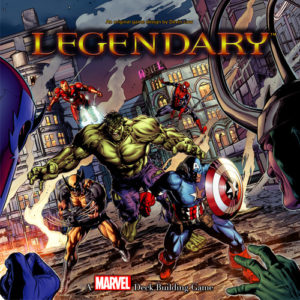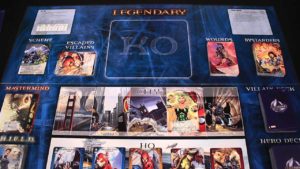
 A few weeks ago I discussed my thoughts on the DC Deck Building Game by Cryptozoic. While the game itself was nothing revolutionary, it provided a fun little diversion for a small time investment. More recently, my girlfriend and I finally broke down and picked up Legendary: Marvel Deck Building by Upper Deck during a sale at our FLGS. I am not ashamed to say that I have had my mind blown in how a deck building game can be designed and played.
A few weeks ago I discussed my thoughts on the DC Deck Building Game by Cryptozoic. While the game itself was nothing revolutionary, it provided a fun little diversion for a small time investment. More recently, my girlfriend and I finally broke down and picked up Legendary: Marvel Deck Building by Upper Deck during a sale at our FLGS. I am not ashamed to say that I have had my mind blown in how a deck building game can be designed and played.
The first thing about this particular game that is so different from every other deck building game that I’ve ever played is that the game is not competitive…well, not completely competitive. The main goal of the game sees you and the other players working cooperatively as Agents of S.H.I.E.L.D. to stop one of the big bads of the Marvel Universe (known as the Mastermind) from completing their evil scheme. If you don’t stop it, the Mastermind wins and everyone loses. As you move through the game, you defeat villains and rescue bystanders that are worth a varying number of victory points. If you defeat the Mastermind, you score up the victory points that you have earned to determine which among you came out on top.
The basic concept of gameplay is similar to every other deck building game. You start the game with a small deck of very basic cards of S.H.I.E.L.D. agents and soldiers and you build your deck by recruiting any number of five hero cards that are available to you at a given time in the “Headquarters” area of the game board. The basic game contains 15 heroes, from the heavy hitters like Captain America, Wolverine, and Spiderman to heroes that don’t necessarily get as much screen time like Gambit and Rogue. Each game has five randomly (or not) chosen heroes that make up the Hero Deck. Each individual hero has a number of different cards that cost a different number of Recruitment Points to buy, giving each of them a number of different things that they can do in a given deck. There is also a Villain Deck that plays against the heroes which is created from several different villain and henchmen groups. The henchmen groups such as the Doom Bot Legion, the Savage Land Mutates or the mutant killing Sentinels form the bulk of the Villain Deck while the villain groups such as Hydra, the Brotherhood of Evil Mutants, or the Enemies of Asgard fill it out with more punch and higher value targets.
 The basic game features four Masterminds – these are the big hitters in the Marvel Universe – Loki, Red Skull, Magneto, and Doctor Doom all make their appearance in the box set, each of them attempting to complete one of eight diabolical schemes chosen at the beginning of the game. These schemes cover major comic events like the Civil War and the Secret Invasion to more straightforward plots such as Unleashing the Power of the Cosmic Cube or Replacing World Leaders with Killbots. Special cards known as Scheme Twists are included in the Villain Deck, advancing the plot as they are revealed through play. If the heroes fail to stop the Mastermind (by defeating them four times), they lose the game. Each Mastermind also has four unique Tactics cards and a Master Strike ability. The Tactic cards are handed out to the player that successfully attacks the Mastermind for victory points and game altering effects. Five Master Strike cards are included in the Villain Deck and are revealed through play like normal, dealing the Mastermind’s Master Strike effect when they are revealed.
The basic game features four Masterminds – these are the big hitters in the Marvel Universe – Loki, Red Skull, Magneto, and Doctor Doom all make their appearance in the box set, each of them attempting to complete one of eight diabolical schemes chosen at the beginning of the game. These schemes cover major comic events like the Civil War and the Secret Invasion to more straightforward plots such as Unleashing the Power of the Cosmic Cube or Replacing World Leaders with Killbots. Special cards known as Scheme Twists are included in the Villain Deck, advancing the plot as they are revealed through play. If the heroes fail to stop the Mastermind (by defeating them four times), they lose the game. Each Mastermind also has four unique Tactics cards and a Master Strike ability. The Tactic cards are handed out to the player that successfully attacks the Mastermind for victory points and game altering effects. Five Master Strike cards are included in the Villain Deck and are revealed through play like normal, dealing the Mastermind’s Master Strike effect when they are revealed.
As you take your turn, you play the six cards that were drawn from your deck at the end of your last turn and generate two different resources: Recruit Points and Attack Power. You use your Recruit Points to purchase the available heroes in the Headquarters. You use your Attack Power to defeat villains and fight the Mastermind. Cards you recruit are added to your deck, increasing the overall power as you buy more powerful heroes. Cards you defeat in combat are added to your Victory Pile which is then totaled up at the end of the game should the heroes be victorious to see who the overall winner is. The order you play your hand cards becomes very important as you build your deck – each hero has a card type, such as a tech hero or a power hero and an affiliation, such as Avengers or X-Men. Some hero cards have bonus effects if they are played after a certain type or affiliation of card is played, allowing you to chain some really impressive effects if your deck is constructed with a certain theme in mind.
The top card of the Villain Deck is played at the beginning of each player’s turn, revealing a Master Strike, Scheme Twist, or a new Villain that enters the City. There are five spots on the City that the Villain advances through as new ones are revealed, pushing them forward. If they are moved to the end of the City before they are defeated, they escape, which results in them defeating an available hero and taking them out of the game. Some Villains have other effects when they escape as well. They can also capture Bystanders, unique cards that are included in the Villain Deck based on how many players are playing the game. A Villain with a Bystander is worth more to defeat and causes more damage if they escape. Certain cards allow a player to rescue Bystanders directly from their unique deck as well, letting you add them directly to your victory pile.
Finally, Wounds exist to weaken your overall deck. They don’t provide any negative effect, but they don’t provide any bonus either. Given that deck size is smaller than many deck building games I’ve played, even a few of them can serve to drastically weaken your deck. You can discard them from your hand and discard pile, but it requires you effectively sacrificing a turn to do so. Still, if half of your hand is Wounds, you could do worse than giving up a turn to get rid of them in one shot…
Deck maintenance is huge, and the game gives you plenty of opportunity to get rid of weaker cards or cards that aren’t doing what you thought they would do when you bought them throughout the game. When done correctly, this can lead to very tight decks that work with a lot of synergy, but can also suffer in a big way when you have to get rid of a hero unexpectedly. The other really compelling part of this game for me is the fact that is supports solo play. I haven’t had a chance to mess around with that particular aspect, but it’s really nice to see a game support it.
There is a lot more to this game that got me really excited when I first started reading through the rules and playing the game, and more that will keep my playing and checking out the various expansions that are still in print. Indeed, it gave me some direction for a game idea I’ve been kicking around but had no idea how to implement. If you’re looking for a deck building game that is a little out of the ordinary, looking for a more cooperative gaming experience, or a tightly themed Marvel gaming experience, you should definitely check out Legendary: Marvel Deck Building. The base game retails for $45-60 depending on where you buy your games. But after only a few plays, I can safely say that it’s worth the price tag, at least it has been in my experience. And with a variety of expansions available for it, I can tell that I’ve only just scratched the surface of what it has to offer.
